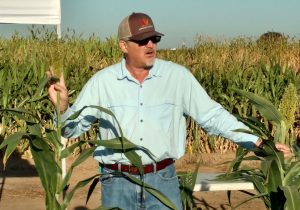The 2017 Alfalfa and Forage Field Day at the Kearney Agricultural Research and Extension (KARE) Center on September 20 provided updates on continuing research projects and offered information on a host of other issues concerning the industry.
 The field day began with a tour of some of the sorghum and alfalfa trials at the facility. Agronomy Advisor for Cooperative Extension in Fresno and Madera Counties, Shannon Mueller, spoke on alfalfa variety selection. “A lot of growers will get their information from the local seed dealer or maybe their PCA and so I wanted to remind them of some of the characteristics that they need to look for when they’re trying to select an alfalfa variety,” Mueller stated.
The field day began with a tour of some of the sorghum and alfalfa trials at the facility. Agronomy Advisor for Cooperative Extension in Fresno and Madera Counties, Shannon Mueller, spoke on alfalfa variety selection. “A lot of growers will get their information from the local seed dealer or maybe their PCA and so I wanted to remind them of some of the characteristics that they need to look for when they’re trying to select an alfalfa variety,” Mueller stated.
Mueller stressed the importance of growers being as informed as possible before making a decision regarding variety, “they want to pull out the paperwork, pull out the data, look on the computer, to look at the performance of the different varieties, select maybe their top two, three, five choices, and then go shopping for seed.”
A common worldwide trend in weed management was discussed, as tolerance for glyphosate continues to be a concern. Attendees were also provided with information on the prevalence of sugarcane aphid in forage sorghum crops and pest management techniques for alfalfa. Water was a major topic at the field day with information being presented on how to optimize surface irrigation, along with techniques to better manage water salinity.
Statewide Alfalfa and Forage Extension Specialist Dan Putnam, addressed the benefits of using subsurface drip irrigation (SDI) in alfalfa, particularly in the Central Valley and areas of the low desert. “Many growers have actually seen some yield benefits from SDI in alfalfa, on the order of 20 to 30 percent, which is pretty dramatic in many cases,” Putnam stated.
There were also some drawbacks to using SDI as well, including cost and rodent damage. “Alfalfa is an ideal habitat for gophers and other kinds of rodents, and this has really been the bane of those people who have tackled drip irrigation in alfalfa. You have to take a no-holds-barred approach for gopher management,” said Putnam.
Water was also a contributing factor to renewed interest in forage sorghum because of its inherent drought tolerance. KARE Director Jeff Dahlberg offered an update on some of the research they have been conducting in their sixth year of evaluating a wide variety of forage sorghums. Using limited amounts of water and fertilizer, their work indicates a potential for sorghum forage crops to still produce high yields. Dahlberg also noted the assistance aerial drones provided in significantly reducing the amount of time required for some of the data recordings.










